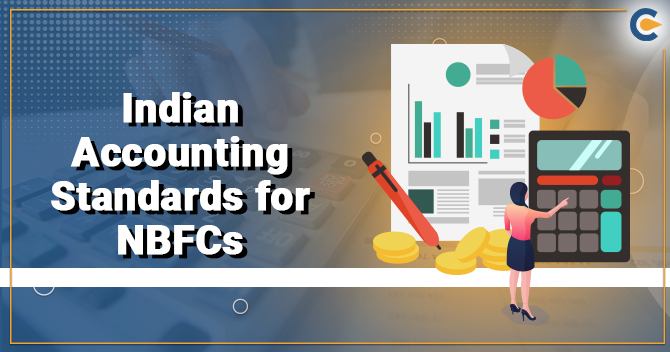The adoption of Indian Accounting Standards has moved our country to the center where transparent financial reporting and high quality prevails. It also makes sure the comparability between the financial statements in pursuant to global accounting standard. It will eventually sync the financial statement to current economic scenarios. While the implementation of Indian Accounting standard has been postponed for financial institutions by a year, the initiative took by the NBFCs for convergence has already begun. In this blog, we will explain the changes in Indian Accounting Standards for NBFCs.
Key Accounting Implication for Non banking financial institution
Here is some key accounting implication for Non-banking financial institution, those are as follows:-


Expected Credit Loss
As against prevailing methods of rule-oriented provision for credit losses, Indian Accounting Standard expects non banking financial institutes to follow a credit loss model where the loss of credit is estimated on the basis of previous financial record and projected credit loss on based on the credit quality assessment.
The advent of Indian Financial Standard may ramp up the charge to P&L account for Non-banking financial companies having significant track record of past Non-Performing Assets. The newly formed entities might struggle to adopt the Indian Accounting Standard as they lack inadequate data pertaining to credit risk and may have to opt for the industrial data.
The model should not only take historical data in the account but also consider the new information depending on customer recovery patterns, profitability of default, recovering time, and recovery anticipated from collaterals (LGD – Loss Given Default).
Variety of attributes used by the Non-Banking Financial Companies while following ECL (Expected Credit Loss) model adheres to challenge to the users on the grounds of analysis and benchmarking performance within the peers.
Amortization of Fee Income under EIR
In general, the concept of lending has always been perceived from the framework of XIRR, which get divided into yield and upfront fees. As per the Indian GAAP, fees were getting appended to Profit & Loss account, meanwhile yield was appending to the tenure of the loan.
Under Indian Accounting Standards, every account will starts exhibiting the commercial understanding and henceforth; fees accrued on credit will have to reduce over the time of the credit. This might defer the revenue recognition for a while. This will negatively impact the profit of non-banking financial companies and their net worth as well. The P&L account will reach to its normal state over the course of time.
Fair Value Implications on Financial Asset
On the commencement of the transition period, all financial assets must be mentioned in the balance sheet at fair value. The impact of the fair valuation may have to be accounted via FVTPL, aka Fair Value through the Statement of Profit or Loss. The FVTPL might negatively impact the profitability of a company. The mark to market gain or losses under every reporting period will significantly impact the sustainability of P&L account.
Additions of Subsidiaries
Some of the Non-banking financial companies have get into joint venture with partners. Most of the them holds shareholders agreement encompassing several rights including veto over certain matter of affairs. Under Indian Accounting Standard, one will have to clarify the definition of “Control” depending on the agreement exist between the partners.
This may leads to some unexpected events- either consolidation of P&L of a joint venture and consolidation of entire balance sheet or deconsolidation of the same, according to the circumstances. These could alter the balance sheet size of the company on the consolidated basis. In some of the scenarios, the Special Purpose Vehicle will be deemed as subsidiaries.
Segment Reporting
Indian Accounting Standards 108 requires the amount pertaining to each segment item must be reported to CODM (Chief Operating Decision Maker) via internal management reports, even if the details doesn’t adhere to Indian Accounting System policies of the company. Furthermore, Account Standard 17 requires the entity to prepare the segment related information in conformity with internal accounting policies for the preparation of its financial statement.
Ind AS 108 advocates the utilization of management report to find out the operating segments. Furthermore, Indian Accounting Standard 108 requires disclosure of segment depending on the entity’s components that the management scrutinizes while making decision regarding operating matters.
Read our article:Glance of Audit Report Format for NBFC
Key considerations for Non-Banking Financial Companies
- NBFCs that adopt manual approach related to EIR or ECL to meet urgent deadlines must revamp their system to overcome inefficacies created by such approach.
- While carrying out the assessment of a business model, NBFCs must determine the relevancy of assumptions that were made prior to COVID 19 by taking the deterioration of asset quality into the account.
- NBFCs should pay attention to the risk management framework and strives to make it flawless in every aspect. The alteration of the ECL model ought to be done with respect to moratorium and COVID 19 impact[1].
- NBFCs must take strategic initiatives related to the periodic calibration of macro-economic overlay model/LGD/PD.
- Streamlined reporting protocols help the entities to achieve well-documented process. Deploy technological framework that facilitates the automation of the financial reporting including the drafting of financial statements including the estimation of the deferred taxes and disclosure.
- Ensure the quality of data during the computation of EIR, ECL, and disclosures pertaining to fair value.
- Deployment of the training modules to help the team to get the sufficient knowledge of accounting and latest industry trends.
- Streamline the audit process by looking for possible loopholes, meet reporting deadlines, and reduce audit preparation time.
Conclusion
In an overall landscape, an improvement in quality and comparability of Indian financials with the worldwide market will give business owners a clear perception of performance which will be a great accomplishment. The impact of financial events and deployment are just transitional in nature.
The mode of recording and reporting transactions by Non-Financial banking companies is up for a change, regulators including corporate affairs and RBI both would play a vital role in assisting corporate’s shift to this scheme of reporting in international formats. Changes in Indian Accounting Standards for NBFCs impart more transparency and rigidity to the accounting structure of the company. Keep in touch with us in case if you seek in-depth information on Indian Accounting Standards for NBFCs or other related topics.
Read our article:Regulations governing NBFCs in India: A Complete Overview











